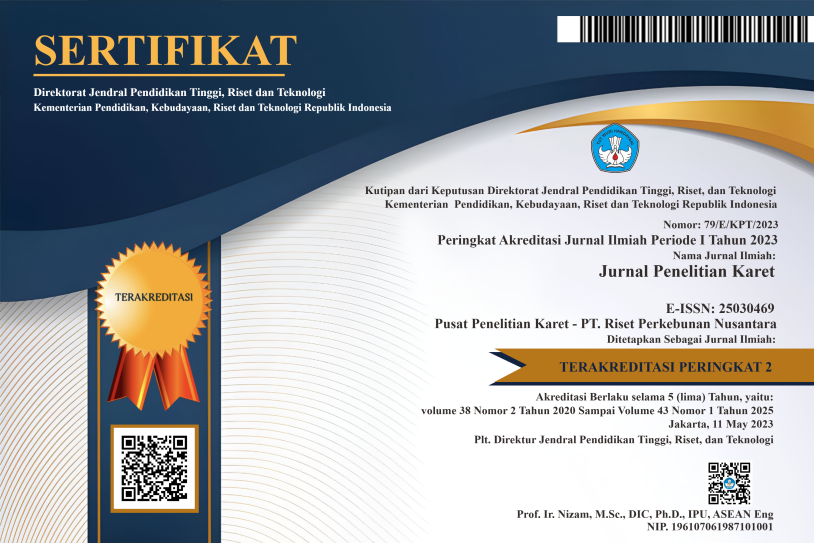DIAGNOSIS PENYAKIT GUGUR DAUN KARET (Hevea brasiliensis Muell. Arg.)
DOI:
https://doi.org/10.22302/ppk.jpk.v2i38.728Keywords:
identification, Koch postulate, Pestalotiopsis microsporaAbstract
One of the causal of the low rubber production is the presence of plant diseases. Important diseases in rubber plants generally cause symptoms of leaf fall, due to Colletotrichum spp., Corynespora sp., and Oidium sp. Currently, there is an incidence of new rubber leaf fall disease with symptoms that are different from the diseases previously found in rubber plantations. This disease is widespread in Sumatra, Kalimantan, and Southeast Asia. There are many suspicions about the pathogens that cause the disease, but there is no precise diagnosis. Therefore, an accurate diagnosis is needed as a basis for determining an effective and efficient disease control strategy. This research was carried out to determine the causal agents of leaf fall disease with symptoms of round leaf spots that can cause leaf fall. Diagnosis was carried out by isolating the pathogen from several rubber clones, inoculating the pathogen to healthy rubber plants, identifying morphologically and molecularly, and re-isolating from inoculated plants. The results of Koch's postulates and morphological and molecular identification determined that the causal agents of leaf fall disease at rubber plants with round spots was the fungus Pestalotiopsis microspora.References
Agrios, G. N. (2005). Plant Pathology. Ed ke-5. Amsterdam: Elsevier Academic Press.
Balodi, R., Bisht, S., Ghatak, A., & Rao, K. H. (2017). Plant disease diagnosis: technological advancements and challenges. Indian Phytopathology, 70(3), 275-281. doi: 10.24838/ip.2017.v70.i3.72487.
Chen, Y., Zeng, L., Shu, N., Jiang, M., Wang, H., Huang, Y., & Tong, H. (2018). Pestalotiopsis-like species causing gray blight disease on Camellia sinensis in China. Plant Disease, 102, 98-106. doi: 10.1094/PDIS-05-17-0642-RE.
Doyle, J. J., & Doyle, J. L. (1990). Isolation of plant DNA from fresh tissue. Focus, 12, 13-15.
Espinoza, J. G., Briceño, E. X., Keith, L. M., & Latorre, B. A. (2008). Canker and twig dieback of blueberry caused by Pestalotiopsis spp. and a Truncatella sp. in Chile. Plant Disease, 92, 1407-1414.
Febbiyanti, T. R., & Fairuza, Z. (2019). Identifikasi penyebab kejadian luar biasa penyakit gugur daun karet di Indonesia. Jurnal Penelitian Karet, 37(2), 193-206. doi: 10.22302/ppk.jpk.v37i2.616.
Febbiyanti, T. R., Kusdiana, A. P. J., Fairuza, Z., & Herlinawati, E. (2018). The outbreak of Fusicoccum leaf disease in Indonesia and the potential yield loss [abstrak]. International Plant Protection Workshop 2018. Palembang: Indonesian Rubber Research Institute dan International Rubber Research and Development Board.
Ferrante, A., & Francini, A. (2006). Ethylene and leaf senescence. In N. A. Khan (Ed.). Ethylene Action in Plants (pp. 51-67). Berlin: Springer. doi: 10.1007/978-3-540-32846-9.
Han, S., Wang, Y., Wang, M., Li, S., Ruan, R., Qiao, T., & Zhu, T. (2019). First report of Pestalotiopsis microspora causing leaf blight disease of Machilus nanmu in China. The American Phytopathological Society. doi: 10.1094/PDIS-05-19-0937-PDN.
Jasalavich, C., Ostrotsky, A., & Jellison, J. (2000). Detection and identification of decay fungi in spruce wood by restriction fragment length polymorphism analysis of amplified genes encoding rRNA. Applied and Environmental Microbiology, 66(11), 4725-4734. doi: 10.1128/AEM.66.11.4725-4734.2000.
Jeewon, R., Liew, E. C. Y., & Hyde, K. D. (2004). Phylogenetic evaluation of species nomenclature of Pestalotiopsis in relation to host association. Fungal Diversity, 17, 39-55.
Maharachchikumbura, S. S. N., Guo, L. D., Cai, L., Chukeatirote, E., Wu, W. P., Sun, X., Crous, P. W., Bhat, D. J., McKenzie, E. H. C., Bahkali, A. H., & Hyde, K. D. (2012). A multi-locus backbone tree for Pestalotiopsis, with a polyphasic characterization of 14 new species. Fungal Diversity, 56(1), 95–129. doi: 10.1007/s13225-012-0198-1.
Maharachchikumbura, S. S. N., Guo, L. D., Chukeatirote, E., Bahkali, A. H., & Hyde, K. D. 2011. Pestalotiopsis—morphology, phylogeny, biochemistry and diversity. Fungal Diversity, 50, 167–187. doi: 10.1007/s13225-011-0125-x.
Maharachchikumbura, S. S. N., Hyde, K. D., Groenewald, J. Z., Xu, J., & Crous, P. W. (2014). Pestalotiopsis revisited. Studies in Mycology, 79, 121–186. doi: 10.1016j.simyco.2014.09.005.
Nagata, N., Ando, Y., & Hirota, A. (1992). Phytotoxins from tea gray blight fungi, Pestolatiopsis longiseta and Pestolotiopsis theae. Bioscience, Biotechnology, and Biochemistry, 56, 810–811.
Pawirosoemardjo, S. (2004). Manajemen pengendalian penyakit penting dalam upaya mengamankan target produksi karet nasional tahun 2020. Prosiding Pertemuan Teknis (pp. 21-45). Palembang: Pusat Penelitian Karet.
Philip, S., Prem, E., & Vineeth, V. K. (2019). New leaf spot disease of rubber. IRRDB Plant Breeder’s Meeting. Malaysia: Malaysia Rubber Board dan International Rubber Research and Development Board.
Rodesuchit, A. (2020). Current situation on the new leaf fall disease in Thailand. Meeting of Expert on Pestalotiopsis Leaf Disease. Thailand: Surat Thani Rubber Research Centre dan International Rubber Research and Development Board.
Shufen, F., Gang, G., & Fucong, Z. (1999). General situation of anthracnose of rubber trees and its researches in China. Proceedings of IRRDB Symposium 1999 (pp. 288-297). Hainan, China: Hainan Publishing House.
Situmorang, A., Sinaga, M. S., Suseno, R., Hidayat, S. H., Siswanto, Darussamin, A. (2004). Status dan manajemen pengendalian penyakit gugur daun Corynespora di perkebunan karet. Prosiding Pertemuan Teknis (pp. 97-118). Palembang: Pusat Penelitian Karet.
Suryaningtyas, H. (2012). Pengendalian penyakit. In M. Lasminingsih et al. (Ed.). Sapta Bina Usahatani Karet Rakyat (pp. 67-80). Palembang: Balai Penelitian Sembawa, Pusat Penelitian Karet.
Turkkan, M., Andolfi, A., Zonno, M. C., Erper, I., Perrone, C., Cimmino, A., Vurro, M., & Evidente, A. (2011). Phytotoxins produced by Pestalotiopsis guepinii, the causal agent of hazelnut twig blight. Phytopathologia Mediterranea, 50, 154-158.
Venkatasubbaiah, P., Dyke, C. G. V., & Chilton, W. S. (1991). Phytotoxins produced by Pestalotiopsis oenotherae, a pathogen of evening primrose. Phytochemistry, 30(5), 1471-1474.
Zambri, A. M. A., Mahyudin, M. M., & Noran, A. S. (2018). Re-Emergence of Hevea leaf spot caused by Pestolotia sp. in Malaysia [abstrak]. Proceeding International Plant Protection Workshop 2018. Palembang: Indonesian Rubber Research Institute dan International Rubber Research and Development Board.
Zhang, M., Wu, H. Y., Tsukiboshi, T., & Okabe, I. (2010). First report of Pestalotiopsis microspora causing leaf spot of hidcote (Hypericum patulum) in Japan. Plant Disease, 94(8), 1064. doi: 10.1094/PDIS-94-8-1064B.
Downloads
Published
How to Cite
Issue
Section
License
Copyright (c) 2020 Alchemi Putri Juliantika Kusdiana

This work is licensed under a Creative Commons Attribution-ShareAlike 4.0 International License.
Submission of a original research article in Jurnal Penelitian Karet implies that the submitted  manuscript has not been published in any scientific journal (except being part of the abstract, thesis, or report). The submitted manuscript also is not under consideration for publication elsewhere. All co-authors involve in the publication of the manuscript should give their approval.
Once, the manuscript is accepted and then published in Jurnal penelitian Karet, the Author(s) keep hold the copyright and retain publishing right without restrictions.
Author(s) and Jurnal Penelitian Karet users are allowed to multiply the published manuscript. The journal users are also permissible to share the published manuscript with an acknowledgement to the Author(s). The Editorial Boards suggest that the Authors should manage patent before publishing their new inventions.
















